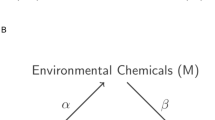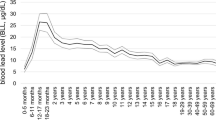Abstract
There is abundant literature finding that susceptibility factors, including race and ethnicity, age, and housing, directly influence blood lead levels. No study has explored how susceptibility factors influence the blood lead–air lead relationship nationally. The objective is to evaluate whether susceptibility factors act as effect measure modifiers on the blood lead–air lead relationship. Participant level blood lead data from the 1999 to 2008 National Health and Nutrition Examination Survey were merged with air lead data from the US Environmental Protection Agency. Linear mixed effects models were run with and without an air lead interaction term for age group, sex, housing age, or race/ethnicity to determine whether these factors are effect measure modifiers for all ages combined and for five age brackets. Age group and race/ethnicity were determined to be effect measure modifiers in the all-age model and for some age groups. Being a child (1–5, 6–11, and 12–19 years) or of Mexican-American ethnicity increased the effect estimate. Living in older housing (built before 1950) decreased the effect estimate for all models except for the 1–5-year group, where older housing was an effect measure modifier. These results are consistent with the peer-reviewed literature of time-activity patterns, ventilation, and toxicokinetics.
This is a preview of subscription content, access via your institution
Access options
Subscribe to this journal
Receive 6 print issues and online access
$259.00 per year
only $43.17 per issue
Buy this article
- Purchase on Springer Link
- Instant access to full article PDF
Prices may be subject to local taxes which are calculated during checkout

Similar content being viewed by others
References
Richmond-Bryant J, Meng Q, Davis JA, Cohen J, Svendsgaard D, Brown JS et al. A multi-level model of blood lead as a function of air lead. Sci Total Environ 2013; 461: 207–213.
Bierkens J, Smolders R, Van Holderbeke M, Cornelis C . Predicting blood lead levels from current and past environmental data in Europe. Sci Total Environ 2011; 409: 5101–5110.
Brunekreef B . The relationship between air lead and blood lead in children - a critical-review. Sci Total Environ. 1984; 38: 79–123.
Hayes EB, McElvaine MD, Orbach HG, Fernandez AM, Lyne S, Matte TD . Long-term trends in blood lead levels among Children in chicago - relationship to air lead levels. Pediatrics 1994; 93: 195–200.
Ranft U, Delschen T, Machtolf M, Sugiri D, Wilhelm M . Lead concentration in the mood of children and its association with lead in soil and ambient air - Trends between 1983 and 2000 in Duisburg. J Toxicol Env Health Part A 2008; 71: 710–715.
Richmond-Bryant J, Meng QY, Davis AJ, Cohen J, Svendsgaard D, Kravets N et al. The influence of declining air lead levels on blood lead–air lead slope factors in children. Environ Health Perspect 2014 (e-pub ahead of print, doi:10.1289/ehp.1307072).
Schwartz J, Pitcher H . The relationship between gasoline lead and blood lead in the United States. J Official Stat 1989; 5: 421–431.
Tripathi RM, Raghunath R, Kumar AV, Sastry VN, Sadasivan S . Atmospheric and children’s blood lead as indicators of vehicular traffic and other emission sources in Mumbai, India. Sci Total Environ 2001; 267: 101–108.
Miranda ML, Edwards SE, Swamy GK, Paul CJ, Neelon B . Blood lead levels among pregnant women: historical versus contemporaneous exposures. Int J Environ Res Public Health 2010; 7: 1508–1519.
Jones RL, Homa DM, Meyer PA, Brody DJ, Caldwell KL, Pirkle JL et al. Trends in blood lead levels and blood lead testing among US children aged 1 to 5 years, 1988-2004. Pediatrics 2009; 123: e376–e385.
Jacobs DE, Wilson J, Dixon SL, Smith J, Evens A . The relationship of housing and population health: a 30-year retrospective analysis. Environ Health Perspect 2009; 117: 597–604.
Egeghy PP, Quackenboss JJ, Sandra CC, Ryan PB . Determinants of temporal variability in NHEXAS-Maryland environmental concentrations, exposures, and biomarkers. J Exp Anal Environ Epidemiol 2005; 15: 388–397.
Strand M, Hopke PK, Zhao W, Vedal S, Gelfand E, Rabinovitch N . A study of health effect estimates using competing methods to model personal exposures to ambient PM2.5. J Exp Sci Environ Epidemiol 2007; 17: 549–558.
Donders ART, van der Heijden GJMG, Stijnen T, Moons KGM . Review: a gentle introduction to imputation of missing values. J Clin Epidemiol 2006; 59: 1087–1091.
Meng Q, Richmond-Bryant J, Davis JA, Cohen J, Svendsgaard D, Brown JS et al. Contribution of particle-size-fractionated airborne lead to blood lead during the National Health and Nutrition Examination Survey, 1999-2008. Environ Sci Technol 2014; 48: 1263–1270.
Gelman A . Struggles with survey weighting and regression modeling. Stat Sci 2007; 22: 153–164.
Rabe-Hesketh S, Skrondal A . Multilevel modelling of complex survey data. J R Stat Soc Ser A Stat Soc 2006; 169: 805–827.
Wu XM, Fan ZT, Ohman-Strickland P . Time-location patterns of a population living in an air pollution hotspot. J Environ Public Health 2010; 2010: 625461.
Klepeis NE, Nelson WC, Ott WR, Robinson JP, Tsang AM, Switzer P et al. The National Human Activity Pattern Survey (NHAPS): a resource for assessing exposure to environmental pollutants. J Exp Anal Environ Epidemiol 2001; 11: 231–252.
USEPA Integrated Science Assessment for Lead (Final Report). In: Agency USEP (ed). Washington, DC, 2013.
James HM, Hilburn ME, Blair JA . Effects of meals and meal times on uptake of lead from the gastrointestinal-tract in humans. Hum Toxicol 1985; 4: 401–407.
Maddaloni M, Lolacono N, Manton W, Blum C, Drexler J, Graziano J . Bioavailability of soilborne lead in adults, by stable isotope dilution. Environ Health Perspect 1998; 106: 1589–1594.
Watson WS, Morrison J, Bethel MIF, Baldwin NM, Lyon DTB, Dobson H et al. Food iron and lead absorption in humans. Am J Clin Nutr 1986; 44: 248–256.
Brownson RC, Baker EA, Housemann RA, Brennan LK, Bacak SJ . Environmental and policy determinants of physical activity in the United States. Am J Public Health 2001; 91: 1995–2003.
Corder K, Ekelund U, Steele RM, Wareham NJ, Brage S . Assessment of physical activity in youth. J Appl Physiol 2008; 105: 977–987.
McCurdy T, Graham SE . Using human activity data in exposure models: analysis of discriminating factors. J Exp Anal Environ Epidemiol 2003; 13: 294–317.
USEPA Exposure Factors Handbook 2011 Edition (Final). In: Agency USEP (ed). Washington, DC, 2011.
Chakraborty J, Zandbergen PA . Children at risk: measuring racial/ethnic disparities in potential exposure to air pollution at school and home. J Epidemiol Commun Health 2007; 61: 1074–1079.
Mohai P, Lantz PM, Morenoff J, House JS, Mero RP . Racial and socioeconomic disparities in residential proximity to polluting industrial facilities: evidence from the Americans’ Changing Lives Study. Am J Public Health 2009; 99: S649–S656.
Perlin SA, Wong D, Sexton K . Residential proximity to industrial sources of air pollution: Interrelationships among race, poverty, and age. J Air Waste Manage Assoc 2001; 51: 406–421.
Wilson SM, Fraser-Rahim H, Williams E, Zhang H, Rice L, Svendsen E et al. Assessment of the distribution of toxic release inventory facilities in metropolitan Charleston: an Environmental Justice Case Study. Am J Public Health. 2012; 102: 1974–1980.
Helsel DR . Fabricating data: how substituting values for nondetects can ruin results, and what can be done about it. Chemosphere 2006; 65: 2434–2439.
Katsouyanni K, Schwartz J, Spix C, Touloumi G, Zmirou D, Zanobetti A et al. Short term effects of air pollution on health: A European approach using epidemiologic time series data: The APHEA protocol. J Epidemiol Commun Health 1996; 50: S12–S18.
Rubin D . Inference and missing data. Biometrika 1976; 63: 581–592.
Sterne JAC, White IR, Carlin JB, Spratt M, Royston P, Kenward MG et al. Multiple imputation for missing data in epidemiological and clinical research: potential and pitfalls. Br Med J 2009; 338: 2393.
Acknowledgements
We give special thanks to Dr. Tom Long and Dr. Zach Pekar for their helpful comments in review of this manuscript. We thank Ms. Nataliya Kravets of the National Center for Health Statistics, Centers for Disease Control, for linking the NHANES data with the AQS and GIS data. Authors from ICF International were funded by contract EP-C-09-009. Authors from academia and the US EPA did not receive external funding for this research.
DISCLAIMER
The research and this manuscript have been reviewed in accordance with US Environmental Protection Agency policy and approved for publication. Mention of trade names or commercial products does not constitute endorsement or recommendation for use. The views expressed in this article are those of the authors and do not necessarily reflect the views or policies of the US Environmental Protection Agency.
Author information
Authors and Affiliations
Corresponding author
Ethics declarations
Competing interests
The authors declare no conflict of interest.
Additional information
Supplementary Information accompanies the paper on the Journal of Exposure Science and Environmental Epidemiology website
Supplementary information
Rights and permissions
About this article
Cite this article
Richmond-Bryant, J., Meng, Q., Cohen, J. et al. Effect measure modification of blood lead–air lead slope factors. J Expo Sci Environ Epidemiol 25, 411–416 (2015). https://doi.org/10.1038/jes.2014.46
Received:
Revised:
Accepted:
Published:
Issue Date:
DOI: https://doi.org/10.1038/jes.2014.46
Keywords
This article is cited by
-
Cumulative Risk and Impact Modeling on Environmental Chemical and Social Stressors
Current Environmental Health Reports (2018)



